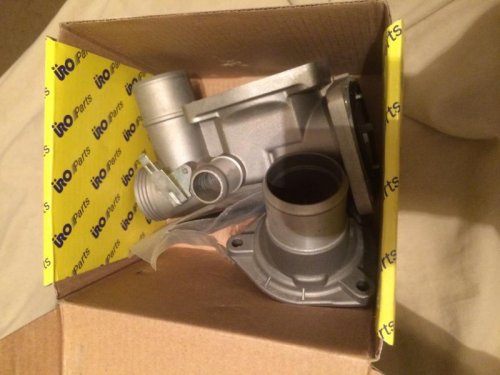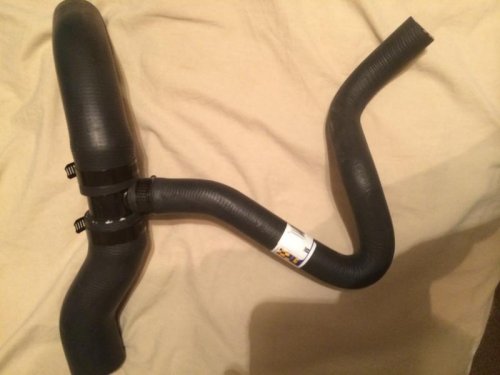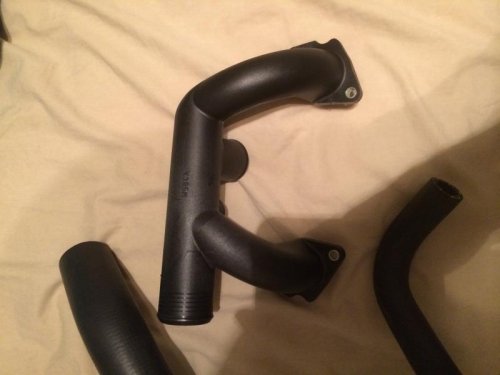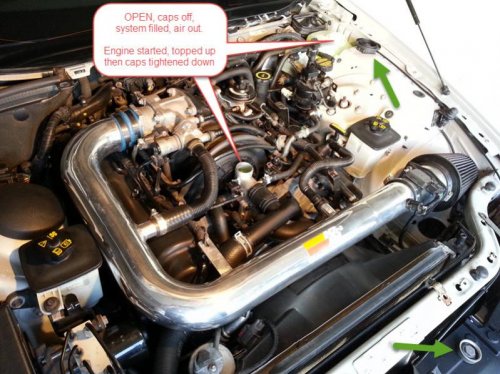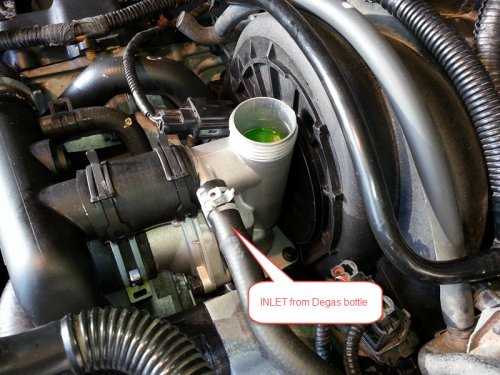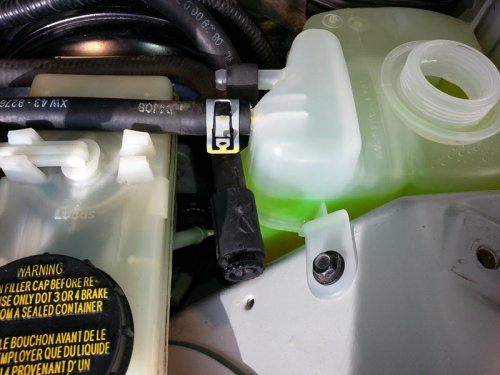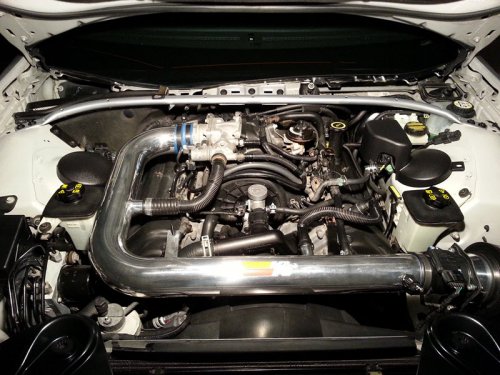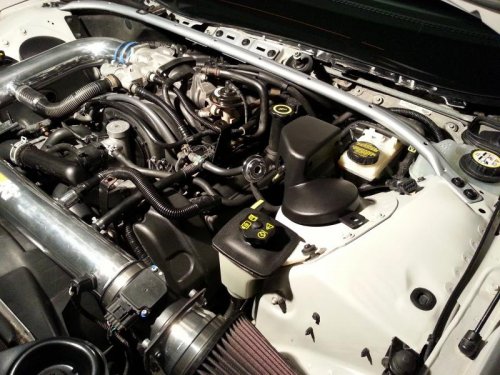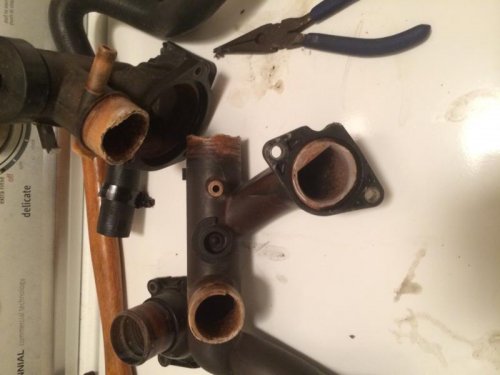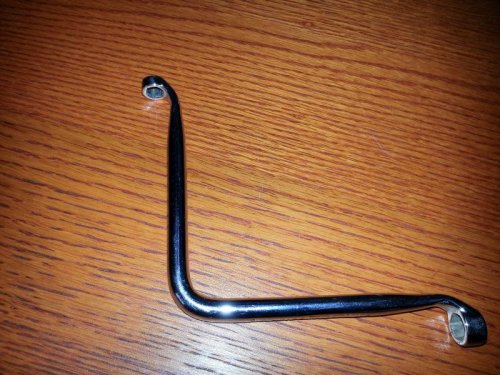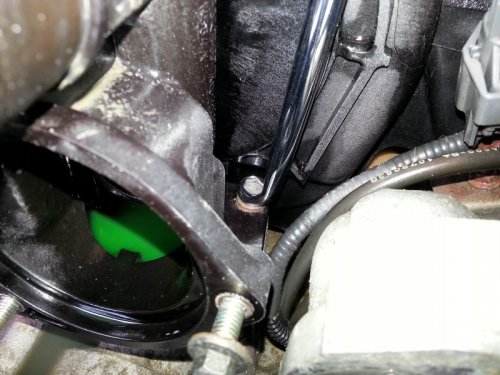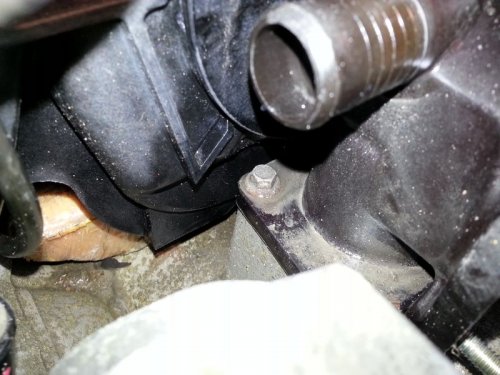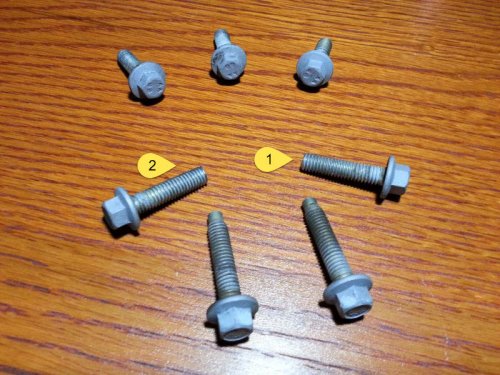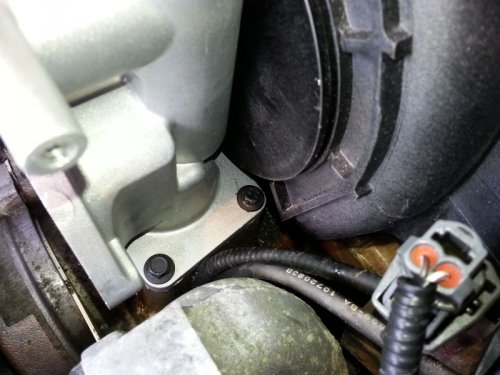Nice ... keep up posted with pics and such. Many of us 1st GEN owners have gone the route of the upgrade Jag Stat housing.
GLWR
----EDIT: ~ just want to add the following:
when you go to add coolant back into the system via the top of the fill neck on the Jag Stat,
fill it to just under the rim a bit and gently start massaging/squeezing the rubber cooling hoses
to assist the system with burping the air throughout. It will come back up at the top of the fill
neck at the stat so therefor do not fill it right to the top as it will spill over.
As you squeeze the lines, it will burp the air out and sink the level at the fill neck back down,
keep doing this while every so often add more coolant to the stat housing fill neck.
When you are convinced you've assisted the coolant through and it won't burp much air back out,
it's time to start filling at the Degas bottle. you'll see the coolant run down the little inlet tube
into the fill neck. Leave your heater drain valve open at the degas bottle, leave the degas cap off for now.
Get someone else to start the car up and hold the RPM up around 2500-2700 and have them turn the
heat right up max with the fan on highest settings, get them to keep holding the RPM's up.
As they do this, you begin to add more coolant to the Jag Stat housing fill neck. On initial start of the
motor the coolant level will drop down inside the neck, you keep filling it to the point where it's right
at the rim where the degas bottle inline tube to Stat and coolant in Stat are level and stays there.
Tell them to keep the RPM's up and steady, not up and down ... important they keep the RPM up steady,
while you continue to fill to the rim at the stat. You can choose to gently squeeze the radiator cooling lines
as you do this, too much and she'll spill over, just enough to see if it want to burp more air or not.
with the RPM's remained steady and you having filled the fill neck to rim cap level it's time to close
the system up by means of tightening the fill neck cap onto the housing. Hand tight for now is fine.
Then keep filling at the degas bottle as the level goes down. Keep the degas bottle cap off for now
and the heater bleed valve open for now as well. While the engine gets up to temperature the level
in the degas bottle will begin to go down, make sure it does not get so low to the point where it
starts to suck air into the system.
Make sure they keep the RPM's up and start to ask them if there appears to be some heat coming
from both facing vents in the center console. Bleed valve will begin to piss coolant out, let it!
should have a catch bucket underneath the car, you'll rinse off everything later.
Eventually the Thermostat is going to pop open once up to temp and allow coolant to now
start flowing through the radiator. Level in degas bottle should relatively stay at same level but
could begin to drop, add coolant if needed.
Once the engine is up to temp and the needle on the dash starts to get to the halfway mark,
it's time to put the cap on the degas bottle with the fluid at the max line.
Observe the drain valve and begin to close this once you are sure it's coming out without spitting air.
Should by now have a closed system and the person in the driver seat holding the RPM's up
should begin to confirm there is plenty of interior heat coming from the vents.
Time to shut her down and let it COMPLETELY cool down! Go wash up, grab a beer, let the engine cool down COMPLETELY!
Once cold, open the degas bottle and fill to max cold line again. Ensure the fill neck cap is in fact on tight.
Bleed valve closed, inspect all around for any coolant leaks, near clamps, bolted down items and such.
You can grab a garden hose and rinse some water down the back near where the bleed valve ran some fluids if need be.
Engine cold, Degas bottle filled back up, bleed valve closed.
Restart engine and get the RPM's up and hold ... wait, let it get up to temp, confirm heat beginning to come from vents.
Open and close drain valve to burp any further air out, keep degas bottle cap closed while bleeding, opening it will reduce
pressure to the system, only open degas bottle when engine back cold.
Go through the routine of warming it back up once more for good measure, add coolant to degas bottle if needed only
when engine is cold. Allow it to get back up to normal running temp and open and close the bleed valve to allow any air to escape.
Should be golden after second or third restart with the bleeding of the air out of the system.
:: if you don't go through the troubles of massaging/squeezing the lines while filling on the initial fill of coolant,
there will be so much air in the system that you'll be bleeding it till the cows come home. Assist it by means
of elevated RPM's, heat/fan on full to pull it through the heater core into the degas escape. Important to close
the fill neck cap at Stat only when engine is getting warmed up and coolant level stays level with top of neck,
closing the cap on the system and not further trapping air into the system.
~ sorry if you already knew all this, we get so many members on here that have trouble bleeding all the air out
correctly and therefore still end up with not enough heat from vents and/or engine overheat due to large pockets of
air trapped within the closed pressurized cooling system. They'll bleed bleed bleed and not get anywhere.
Lots of additional info here:
http://www.lincolnvscadillac.com/fo...ng-Climate-Control-System-No-Heat-Information
